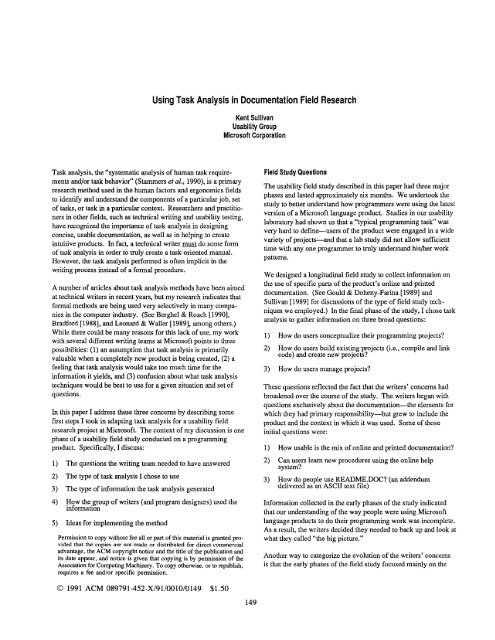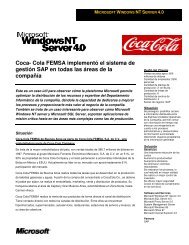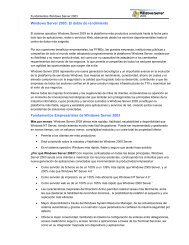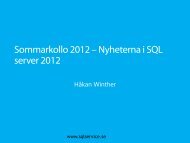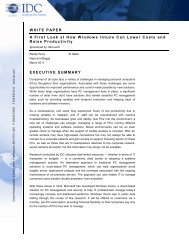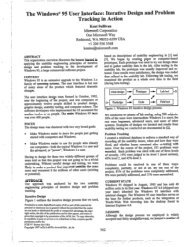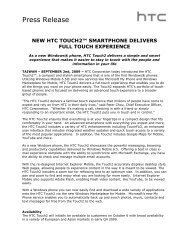Using Task Analysis in Documentation Field Research - Microsoft
Using Task Analysis in Documentation Field Research - Microsoft
Using Task Analysis in Documentation Field Research - Microsoft
Create successful ePaper yourself
Turn your PDF publications into a flip-book with our unique Google optimized e-Paper software.
<strong>Task</strong> analysis, the “systematic analysis of human task require-<br />
ments and/or task behavior” (Stammers et al., 1990), is a primary<br />
research method used <strong>in</strong> the human factors and ergonomics fields<br />
to identify and understand the components of a particular job, set<br />
of tasks, or task <strong>in</strong> a particular context. <strong>Research</strong>ers and practitio-<br />
ners <strong>in</strong> other fields, such as technical writ<strong>in</strong>g and usability test<strong>in</strong>g,<br />
have recognized the importance of task analysis <strong>in</strong> design<strong>in</strong>g<br />
concise, usable docurnentatiou as well as <strong>in</strong> heIp<strong>in</strong>g to create<br />
<strong>in</strong>tuitive products. In fac~ a technical writer ~ do some form<br />
of task analysis <strong>in</strong> order to truly create a task-oriented manual.<br />
However, the task analysis performed is often implicit <strong>in</strong> the<br />
writ<strong>in</strong>g process <strong>in</strong>stead of a formal procedure.<br />
A number of articles about task analysis methods have been airned<br />
at tectilcal writers <strong>in</strong> recent years, but my research <strong>in</strong>dicates that<br />
formal methods are be<strong>in</strong>g used very selectively <strong>in</strong> many compa-<br />
nies <strong>in</strong> the computer <strong>in</strong>dushy. (See Berghel & Roach [ 1990],<br />
Bradford [1988], and Leonard & Wailer [1989], among orhers.)<br />
While there could be many reasons for thk lack of use, my work<br />
with several different writ<strong>in</strong>g teams at <strong>Microsoft</strong> po<strong>in</strong>ts to three<br />
possibilities (1) an assumption that task analysis is primarily<br />
valuable when a completely new product is be<strong>in</strong>g created, (2) a<br />
feel<strong>in</strong>g that task analysis would take too much time for the<br />
<strong>in</strong>formation it yields, and (3) confusion about what task analysis<br />
techniques would be best to use for a given situation and set of<br />
questions.<br />
In thk paper I address these three concerns by describ<strong>in</strong>g some<br />
first steps I took <strong>in</strong> adapt<strong>in</strong>g task analysis for a usability field<br />
research project at <strong>Microsoft</strong>. The context of my discussion is one<br />
phase of a usability field study conducted on a programm<strong>in</strong>g<br />
product. Specifically, I discuss:<br />
1) The questions the writ<strong>in</strong>g team needed to have answered<br />
2) The type of task analysis I chose to use<br />
3) The type of <strong>in</strong>formation the task analysis generated<br />
4) How the group of writers (and program designers) used the<br />
<strong>in</strong>formation<br />
5) Ideas for implement<strong>in</strong>g the method<br />
Permission to copy without fee all or part of this material is granted provided<br />
that tbe copies are not made or distributed for direct commercial<br />
advantage, the ACM copyright notice and the title of the publication and<br />
its date appear, and notice is given that copy<strong>in</strong>g is by permission of the<br />
Association for Comput<strong>in</strong>g Mach<strong>in</strong>ery. To copy otherwise, or tn repubtish,<br />
requires a fee and/or specific permission.<br />
@ 1991 ACM 089791 -452-X/91 /OO10/O149 $1.50<br />
<strong>Us<strong>in</strong>g</strong> <strong>Task</strong> <strong>Analysis</strong> <strong>in</strong> <strong>Documentation</strong> <strong>Field</strong> <strong>Research</strong><br />
Kent Sullivan<br />
UsabilityGroup<br />
<strong>Microsoft</strong>Corporation<br />
149<br />
<strong>Field</strong> Study Questions<br />
The usability field study described <strong>in</strong> this paper had three major<br />
phases and lasted approximately six months. We undertook the<br />
study to better understand how programmers were us<strong>in</strong>g the latest<br />
version of a <strong>Microsoft</strong> language product. Studies <strong>in</strong> our usability<br />
laboratory had shown us that a “typical programm<strong>in</strong>g task” was<br />
very hmd to def<strong>in</strong>e-users of the product were engaged <strong>in</strong> a wide<br />
variety of projects-and that a lab study did not allow sufficient<br />
time with any one programmer to truly understand his/her work<br />
patterns.<br />
We designed a longitud<strong>in</strong>al field study to collect <strong>in</strong>formation on<br />
the use of specific parts of the product’s onl<strong>in</strong>e and pr<strong>in</strong>ted<br />
documentation. (See Gould & Doheny-Far<strong>in</strong>a [1989] and<br />
Sullivan [1989] for discussions of the type of field study tech-<br />
niques we employed.) In the f<strong>in</strong>al phase of the study, I chose task<br />
analysis to gather <strong>in</strong>formation on three broad questions:<br />
1) How do users conceptualize their programm<strong>in</strong>g projects?<br />
2) How do users build exist<strong>in</strong>g projects (i.e., compile and l<strong>in</strong>k<br />
code) and create new projects?<br />
3) How do users manage projects?<br />
These questions reflected the fact that the writers’ concerns had<br />
broadened over the course of the study. The writers began with<br />
questions exclusively about the documentation-the elements for<br />
which they had primary responsibility-but grew to <strong>in</strong>clude the<br />
product and the context <strong>in</strong> which it was used. Some of those<br />
<strong>in</strong>itial questions were:<br />
1) How usable is the mix of onl<strong>in</strong>e and pr<strong>in</strong>ted documentation?<br />
2) Can users learn new procedures us<strong>in</strong>g the onl<strong>in</strong>e help<br />
syswm?<br />
3) How do eople use README.DOC? (an addendum<br />
c!<br />
delivere as an ASCII text file)<br />
Information collected <strong>in</strong> the early phases of the study <strong>in</strong>dicated<br />
that our understand<strong>in</strong>g of the way people were us<strong>in</strong>g <strong>Microsoft</strong><br />
language products to do their programm<strong>in</strong>g work was <strong>in</strong>complete.<br />
As a resul~ the writers decided they needed to back up and look at<br />
what they called “the big picture.”<br />
Another way to categorize the evolution of the writers’ concerns<br />
is that the edy phases of the field study focused ma<strong>in</strong>ly on the
tasks the writers and documentation system anticipated (ahhough<br />
task analysis methods were not used). The f<strong>in</strong>al phase of the<br />
study, however, focused specifically on the tasks the programmers<br />
needed to accomplish.<br />
Type of <strong>Task</strong> <strong>Analysis</strong> Chosen<br />
Ju task analysis, the basic technique-the decomposition of a<br />
whole <strong>in</strong>to its parts-is constant across the many implementat-<br />
ions, but the focus and level at which the decomposition starts<br />
and ends varies widely, depend<strong>in</strong>g on the questions to be<br />
answered. In choos<strong>in</strong>g the type of task analysis for this field<br />
study, I first had to carefully analyze the questions the writers had<br />
expressed. Their <strong>in</strong>itial set of questions was much larger, and<br />
some of the questions and underly<strong>in</strong>g issues overlapped. As is<br />
typical <strong>in</strong> usability test<strong>in</strong>g, I asked for clarification on the issues,<br />
which <strong>in</strong> turn narrowed the number of questions and sharpened<br />
their focuses. (See Dieli [1989] for a discussion of the problem<br />
def<strong>in</strong>ition process the <strong>Microsoft</strong> usability group uses,) This<br />
careful def<strong>in</strong>ition of the exact questions to be addressed had a<br />
dramatic impact on the type of task analysis chosen and helped<br />
ensure that the data collected matched the writers’ expectations.<br />
The type of task analysis I chose was hierarchical and borrowed<br />
ideas from several sources, <strong>in</strong>clud<strong>in</strong>g Wigley (1985). In a<br />
hierarchical task analysis, each task is analyzed by “break<strong>in</strong>g it<br />
<strong>in</strong>to task elements or goals which become <strong>in</strong>creas<strong>in</strong>gly detailed as<br />
the hierarchy progresses” (Stammers et rd., 1990). The most<br />
general <strong>in</strong>formation is placed at the top of the hierarchy, with the<br />
more specific <strong>in</strong>formation follow<strong>in</strong>g on lower levels. (See Figure<br />
1 for a diagram of part of a task hierarchy. It is discussed <strong>in</strong> more<br />
detail <strong>in</strong> the follow<strong>in</strong>g section.)<br />
AS discussed <strong>in</strong> Stammers et al., (1990), the hierarchical method<br />
can allow an economical approach-areas of little <strong>in</strong>terest can be<br />
treated superficially without risk to more important areas. This<br />
feature was especially attractive tome because of the limited<br />
amount of time I had to complete the task analysis. I was a guest<br />
of the various companies participat<strong>in</strong>g <strong>in</strong> the field study, so I<br />
didn’t have unlimited access to the sites or subjects. And, as usual<br />
<strong>in</strong> the computer <strong>in</strong>dustry, the clients of the field study (the writers)<br />
wanted the <strong>in</strong>formation quickly so they could beg<strong>in</strong> us<strong>in</strong>g it on the<br />
next iteration of the product.<br />
Other task analysis techniques would have been appropriate for<br />
different questions. For example, had one of the questions been<br />
“What <strong>in</strong>formation do users need to have <strong>in</strong> order to successfislly<br />
use the debugger?” then a task analysis focus<strong>in</strong>g on knowledge<br />
description could have been used (Johnson et al., 1984).<br />
To collect this <strong>in</strong>formation, several techniques were employed.<br />
They are described <strong>in</strong> Table 1 below:<br />
150<br />
Table 1: DataCollectionTechniques<br />
Data Collection Technique & Rationale<br />
Topic Covered<br />
Interview: Description of Learn about subjects’ job<br />
List 3 programm<strong>in</strong>g responsibilities and perception<br />
projects and general of the site’s programm<strong>in</strong>g<br />
programm<strong>in</strong>g process r.wocess<br />
Observation 1: Use of the Identify tasks <strong>in</strong> creat<strong>in</strong>g a new<br />
language product to create project <strong>in</strong> subjects’ work<br />
the essential items of a environments<br />
new project<br />
Observation 2 Use of the Identify tasks <strong>in</strong> build<strong>in</strong>g an<br />
product to build current exist<strong>in</strong>g project and tasks<br />
project and organize files <strong>in</strong>volved <strong>in</strong> shar<strong>in</strong>g project files;<br />
for workgroup access also confirm each subject’s job<br />
Th<strong>in</strong>k<strong>in</strong>g-aloud prOtOCOk<br />
Verbal report of thoughts<br />
while under observation<br />
Types of Information Generated<br />
duties<br />
Understand why subjects were<br />
do<strong>in</strong>g each task and collect<br />
<strong>in</strong>formation on mental models<br />
As described <strong>in</strong> Table 2 below, four major types (levels) of<br />
<strong>in</strong>formation were collected: site, job, task, and element. As shown<br />
<strong>in</strong> the table, each of the levels of analysis served a different<br />
purpose.<br />
Table 2: FourLevelsof <strong>Analysis</strong><br />
Level of <strong>Analysis</strong> Def<strong>in</strong>ition/Use for Information<br />
Site Each of the companies <strong>in</strong> the study was a<br />
site, Information collected helped place<br />
the subjects from that site <strong>in</strong> the overall<br />
organization-size of programm<strong>in</strong>g<br />
group, softwwe products produced, etc.<br />
Job Each of the programmers at a site had a<br />
specific job. Information collected helped<br />
def<strong>in</strong>e what it really meant to be a<br />
“professional programmer” by identify<strong>in</strong>g<br />
the different responsibilities of each<br />
subject,<br />
<strong>Task</strong> Each programmer did a set of core tasks.<br />
Information collected helped describe what<br />
subjects expected the language product to<br />
do for them.<br />
Element Most tasks wuld be broken down <strong>in</strong>to a<br />
set of “elements”, which are discrete<br />
actions or steps executed dur<strong>in</strong>g the<br />
performance of a task. Information<br />
collected helped descnhe each core task<br />
and establish how subjects performed each<br />
task.
Addhionally, the site and job <strong>in</strong>formation together helped<br />
establish a base for compar<strong>in</strong>g the task and element <strong>in</strong>formation<br />
among sites. By understand<strong>in</strong>g the similarities and differences of<br />
the subjects’ jobs and their workgroups we were able to identify<br />
patterns where appropriate and keep restilts separate where not.<br />
In the task hierarchy, the “site” data I collected was typically<br />
entered firs~ at the top, because it was the most general. The<br />
other data-job, task and element-was then entered <strong>in</strong> the lower<br />
parts of the hierarchy. The job, task, and element <strong>in</strong>formation re-<br />
described the site data <strong>in</strong> more specific terms. For example, <strong>in</strong><br />
order to answer question 2, “How do users build exist<strong>in</strong>g projects<br />
(i.e., compile and l<strong>in</strong>k code) and create new projects?”, a high-<br />
level analysis of workgroups draw<strong>in</strong>g from site and job <strong>in</strong>forma-<br />
tion was completed first. Then, a detailed look at subjects’<br />
<strong>in</strong>teraction with the specific “project setup” commands <strong>in</strong> the<br />
programm<strong>in</strong>g producg draw<strong>in</strong>g from task and element dat% was<br />
done. (See Figure 1 for a diagram of par{ of a task hierarchy.)<br />
The process was often recursive—low level task and element data<br />
refocused the higher level categories.<br />
Figure1:Sample<strong>Task</strong>Hierarchy(partial)<br />
Subject 6—<strong>Task</strong> 2<br />
Build Exist<strong>in</strong>g Project I<br />
compile & l<strong>in</strong>k code)<br />
Decide on<br />
build flags<br />
/<br />
Get current<br />
versions of all<br />
the code<br />
. 1 : El<br />
Chowe build<br />
method<br />
Once the detailed data concern<strong>in</strong>g how subjects created, built, and<br />
ma<strong>in</strong>ta<strong>in</strong>ed their projects was analyzed <strong>in</strong> the task hierarchy, it<br />
was possible to summarize the data <strong>in</strong> a series of <strong>in</strong>creas<strong>in</strong>gly-<br />
s~cific ~bles. E=h ~ble was alSO =comp~ied bY a PrOSe<br />
discussion. Each of these tables represen ted the <strong>in</strong>formation from<br />
one or more nodes on the same level of the task hierarchy.<br />
Tables 3 and 4 show an example of the tr~bles created <strong>in</strong> order to<br />
answer question 2, “How do users build exist<strong>in</strong>g projects (i.e.,<br />
compile and l<strong>in</strong>k code) and create new p] ejects?” Table 3 below<br />
def<strong>in</strong>es the three stages of a typical progx atntn<strong>in</strong>g project for the<br />
subjects. This data is on a fairly high level.<br />
Table 4 below describes subjects’ irtterac tion with the product’s<br />
commands for build<strong>in</strong>g a project (compil<strong>in</strong>g and l<strong>in</strong>k<strong>in</strong>g code) <strong>in</strong><br />
the “middle” and “late” stages. This data is on a much more<br />
elemental level.<br />
The high-level data concern<strong>in</strong>g how the subjects conceptualized<br />
their projects was not presented <strong>in</strong> tables but <strong>in</strong>stead <strong>in</strong> flowcharts<br />
of their development processes. A prose summary of the<br />
similarities and differences between sites was also <strong>in</strong>cluded. The<br />
flowcharts clearly depicted the multiple itctivities that often were<br />
occurr<strong>in</strong>g simultaneously, which is difficult to do with a table.<br />
(Figure 2 below shows part of a sample flowchart.)<br />
m<br />
151<br />
How theInformationwaeUeed<br />
Feedback from the writers and other members of the languages<br />
product group <strong>in</strong>dicates that the <strong>in</strong>formation generated by the task<br />
analysis has had impact <strong>in</strong> four ma<strong>in</strong> ways:<br />
.<br />
.<br />
●<br />
Described workerouu dvnamics and elucidated ideas for tools<br />
to meet zrotm moiect demands. Site and job <strong>in</strong>formation told<br />
the language product’s designers that the programmers were<br />
work<strong>in</strong>g ahnost exclusively <strong>in</strong> groups. The <strong>in</strong>formation also<br />
described how dtey used different tools to manage group<br />
projects. The task analysis also highlighted that prograrmn<strong>in</strong>g<br />
groups of all sizes, not just large ones, shared responsibilities<br />
and code on projects. One or more programmers <strong>in</strong> each group<br />
s~nt a lot of time manag<strong>in</strong>g the group’s activities. The bsk<br />
analysis gave the designers <strong>in</strong>formation on how they might<br />
design tools to ease the project management task and also<br />
provide more powerful capabilities.<br />
Coni%rned the existence of houblesome <strong>in</strong>terface components.<br />
The task analysis data also confiimed that parts of the <strong>in</strong>terface<br />
of the programm<strong>in</strong>g product were hard to use. Observations<br />
conducted <strong>in</strong> an earlier phase of the field study po<strong>in</strong>ted to<br />
problems with a specific series of menu commands and dialog<br />
boxes. The task analysis showed that one core programm<strong>in</strong>g<br />
task did not map well onto the cmnrnand structure of the<br />
language product. The programmers had a clear picture of<br />
what they needed to accomplish but had considerable difficulty<br />
choos<strong>in</strong>g the correct commands and sett<strong>in</strong>gs to complete the<br />
task. The task analysis data gave the writers ammunition for<br />
advocat<strong>in</strong>g change <strong>in</strong> the product through meet<strong>in</strong>gs with the<br />
program management for the product.<br />
Clarified and gave detail on how subiects def<strong>in</strong>ed a “tvDical<br />
prozrarmnirw m oiect”. <strong>Task</strong> analysis data clarified end<br />
provided useful detail on how the programmers divided their<br />
projects <strong>in</strong>to three fairly dist<strong>in</strong>ct phases (early, middle, and late)<br />
and how they were us<strong>in</strong>g the language product <strong>in</strong> each phase.<br />
(See Table 3 below for a more complete summary.)<br />
Table 3: ThreeStages<strong>in</strong> a TypicalProject<br />
Stage Common Actions<br />
EtK.!Y Write shell of program and a few functions<br />
Plann<strong>in</strong>g/ before attempt<strong>in</strong>g first compile; spend<br />
Experiment<strong>in</strong>g time sett<strong>in</strong>g up build/compiler/l<strong>in</strong>k<br />
options; do <strong>in</strong>itial compiles to check<br />
syntax of code; beg<strong>in</strong> buildtng (i.e.<br />
<strong>in</strong>clude l<strong>in</strong>k<strong>in</strong>g)<br />
Middle: Work iteratively-make small changes<br />
Cod<strong>in</strong>~ and do builds often to check correctness;<br />
Debugg<strong>in</strong>g use debugger to track down troublesome<br />
uroblems<br />
lJJE Change build/compiler/l<strong>in</strong>k options to<br />
Test<strong>in</strong>gf what is wanted for the f<strong>in</strong>al release<br />
Releas<strong>in</strong>g product; build release version and test;<br />
change build options back to “debug” and<br />
work iteratively to remove rema<strong>in</strong><strong>in</strong>g<br />
bugs; change options back to “release”<br />
and prepare f<strong>in</strong>al builds
● Contributed to a raised awareness of the user’s perspective.<br />
The report conta<strong>in</strong><strong>in</strong>g the task analysis results con~ibuted to a<br />
raised awareness of users and the successes and failures they<br />
were hav<strong>in</strong>g with the programm<strong>in</strong>g product. Several follow-up<br />
laboratory usability tests were conducted on the next version of<br />
the product to help ensure its <strong>in</strong>terface improved.<br />
Figure 2: Programm<strong>in</strong>gProcess Flowcharl (partial)<br />
Month 1... Month 2...<br />
Get project<br />
(Department<br />
needs sometb<strong>in</strong>g—<br />
how can we do it<br />
and fit it <strong>in</strong>to our<br />
long-range goals?)<br />
Defiie project—<br />
the spec<br />
-Design screens<br />
-Design k<strong>in</strong>ds of<br />
reports the system<br />
will need to<br />
generate<br />
Table 4: Useof ProjectBuild<strong>in</strong>gCommands<br />
Command Use<br />
Start play<strong>in</strong>g with<br />
code to get a<br />
handle on the<br />
tools to do the job:<br />
consult Petzold,<br />
look at the<br />
example programs<br />
(pr<strong>in</strong>ted and<br />
onl<strong>in</strong>e) and ask<br />
MS questions<br />
(Onl<strong>in</strong>e)<br />
Hand off<br />
prelim<strong>in</strong>ary spec<br />
to support<br />
personnel -They<br />
write the formal<br />
Spec<br />
Build Used almost exclusively <strong>in</strong> the middle<br />
.exe and late stages<br />
Compile File: Used occasionally to check the<br />
.C syntax of a new piece of code and<br />
when experiment<strong>in</strong>g<br />
Rebuild All Used occasionally to (1) make sure all<br />
code be<strong>in</strong>g tested was up to date, (2)<br />
see if a mysterious bug was be<strong>in</strong>g<br />
caused by out of date code, and (3)<br />
prepare f<strong>in</strong>al release candidates<br />
Build Target... Not used—subjects did not understand<br />
the purpose<br />
152<br />
Implementation Ideas<br />
The task analysis described <strong>in</strong> this paper provided <strong>in</strong>formation on<br />
a variety of levels, The method, <strong>in</strong> general, is very flexible<br />
adaptable to most any set of questions concern<strong>in</strong>g users, tasks, and<br />
software. While task analysis data was used to answer broad<br />
questions about the programm<strong>in</strong>g process, task analysis can also<br />
be used to focus on very detailed, <strong>in</strong>terface-specific questions,<br />
Given the method’s flexibility, one may wonder how best to use<br />
the method. Because documentation writers can use formal task<br />
analysis to improve the materials they produce-manuals, tra<strong>in</strong>iig<br />
materials, etc.—as well as <strong>in</strong> the actual product be<strong>in</strong>g docu-<br />
mente+ there are a number of areas which can be addressed.<br />
Here are a few general ideas for areas to explore:<br />
1)<br />
2)<br />
3)<br />
4)<br />
Ensurirw that mom-m desixners have <strong>in</strong>formation about<br />
users’ expectations and needs. It could be an impossible task<br />
to create documentation for a program that doesn’ t do what<br />
users expat or need. <strong>Task</strong> analysis can reveal what users<br />
want to do so that writers aren’ t forced to compensate for<br />
<strong>in</strong>adequate or needlessly complicated product features.<br />
Focus<strong>in</strong>g documentation on the tasks the user br<strong>in</strong>gs to a<br />
product rather than on the tasks the svstem allows. Formal<br />
task analysis might reveal that a “task-oriented” manual is<br />
describ<strong>in</strong>g the wrong set of tasks. (Do users really have a<br />
task they call “Formatt<strong>in</strong>g a paragraph”? Or is their tm.k<br />
someth<strong>in</strong>g else, like: “Prepar<strong>in</strong>g this memo us<strong>in</strong>g the format<br />
my boss prefers?”)<br />
Understand<strong>in</strong>g what comb<strong>in</strong>ation of basic and advanced<br />
features of a uromun users deuend on to comulete their<br />
*. <strong>Task</strong> analysis can help writers decide which featores<br />
to discuss prom<strong>in</strong>ently and which features to save for<br />
advanced topics. This <strong>in</strong>formation can also help program<br />
designers see which features are not be<strong>in</strong>g used.<br />
Clarifyirw the “tYuical user’s” set of tasks. Formal task<br />
analysis can help writers identify where their audience’s task<br />
set differs from the model the writers have built based on<br />
their own <strong>in</strong>tuitions, experience, and <strong>in</strong>formal task analysis<br />
(i.e., with co-workers).<br />
Conclusions<br />
Formal task analysis methods provided valuable <strong>in</strong>formation<br />
about professional programmers’ everyday tasks and how they<br />
were us<strong>in</strong>g a <strong>Microsoft</strong> programm<strong>in</strong>g product to complete those<br />
tasks. The <strong>in</strong>formation has had considerable impact on not only<br />
the language product’s documentation but the product itself.<br />
Future versions of the product have been designed and usability<br />
tested with the gord of help<strong>in</strong>g users complete their tasks more<br />
efficiently and completely. The language products team, as well<br />
as the usability group, are enthusiastic about the cont<strong>in</strong>ued use of<br />
task analysis to gather more knowledge about users and their<br />
tasks.
A long-stand<strong>in</strong>g rule <strong>in</strong> the computer sof:ware <strong>in</strong>dustry is that<br />
each new version of a software product adds more features, and<br />
by extension, more complexity. An unfortunate corollary is the<br />
documentation that describes the product also becomes kuger and<br />
more complex. <strong>Task</strong> analysis can help both documentation<br />
writers and software designers m<strong>in</strong>imize this complexity by<br />
identify<strong>in</strong>g the exact features rmd <strong>in</strong>form ~tion users expect and<br />
use to do their work.<br />
Acknowledgements<br />
My thanks go to Marshall McCl<strong>in</strong>tock and Mark Simpson for<br />
their many ideas zmd critical reviews; to Mary Dieli, Richard<br />
Gold, Patrick Kelley, and Will Sibbald fcjr feedback and reviews;<br />
to Lisa Dreger for valuable graphic design ideas.<br />
References<br />
Berghel, H. & Roach, D. (1990). <strong>Documentation</strong> Design Based<br />
upon Intuitive Feature Taxonomy and Use Logg<strong>in</strong>g. SIGDOC ’91)<br />
Conference Proceed<strong>in</strong>gs.<br />
Bradford A. (1988). What is a <strong>Task</strong> Anidysis Matrix? Proceed-<br />
<strong>in</strong>gs of the 35th ITCC.<br />
Dieli, M. (1989). Usability Evahzation Involv<strong>in</strong>g Writers <strong>in</strong> the<br />
Problem Def<strong>in</strong>kion Process. Proceed<strong>in</strong>gs of the 1989 IPCC.<br />
Gould, E. & Doheny-Far<strong>in</strong>a, S. (1989). !Itudy<strong>in</strong>g Usability <strong>in</strong> the<br />
<strong>Field</strong> Qualitative <strong>Research</strong> Techniques for Technical Communi-<br />
cators. In Doheny-Far<strong>in</strong>~ S. (Ed.), Effective <strong>Documentation</strong>:<br />
What We Have Learnedjiom <strong>Research</strong> (Chapter 16). Cambridge,,<br />
MA MIT Press.<br />
Leonard, D. & Wailer, A. L. (1989). Usability Plann<strong>in</strong>g for End<br />
User Tra<strong>in</strong><strong>in</strong>g. SIGDOC ’89 Conference Proceed<strong>in</strong>gs.<br />
Stammers, R., Carey, M., & Astley, J. (1’290). <strong>Task</strong> <strong>Analysis</strong>. In<br />
Wilson, J.& Corlet~ E. N. (Eds.), Evaluation of Human Work<br />
(Chapter 6). Bristol, PA: Taylor & Francis.<br />
Sullivan, P. (1989). Usability <strong>in</strong> the Computer Industry: What<br />
Contribution Can Longitud<strong>in</strong>al <strong>Field</strong> Studies Make? Proceed<strong>in</strong>gs<br />
of the 1989 IPCC.<br />
Wigley, W. (1985). INPO / Industry Job and <strong>Task</strong> <strong>Analysis</strong><br />
Efforts. Proceed<strong>in</strong>gs of the IEEE Third Conference on Human<br />
Factors and Power Plants.<br />
153


